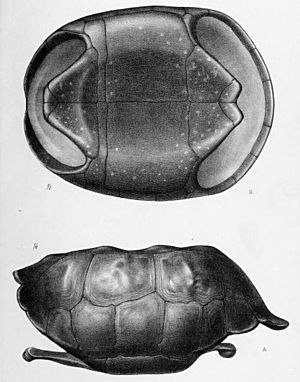Floreana giant tortoise facts for kids
Quick facts for kids Chelonoidis niger niger |
|
|---|---|
 |
|
| Illustration of the shell | |
| Conservation status | |
| Scientific classification |
|
| Kingdom: | Animalia |
| Phylum: | Chordata |
| Class: | Reptilia |
| Order: | Testudines |
| Suborder: | Cryptodira |
| Family: | Testudinidae |
| Genus: | Chelonoidis |
| Species: | |
| Subspecies: |
†C. n. niger
|
| Trinomial name | |
| Chelonoidis niger niger (Quoy & Gaimard, 1824)
|
|
| Synonyms | |
|
|
The Floreana giant tortoise (Chelonoidis niger niger) was a type of Galápagos tortoise. It was also known as the Charles Island giant tortoise. These amazing creatures lived only on Floreana Island in the Galápagos Islands. This group of islands is in the Pacific Ocean, right near the equator.
The name niger means 'black'. This probably refers to the color of the first tortoise specimen studied. For a while, its name was mistakenly spelled nigra. But scientists corrected it in 2017.
Contents
Understanding the Floreana Tortoise
This tortoise is part of a larger group called Chelonoidis niger. This group includes all the different kinds of Galápagos tortoisees. The Floreana tortoise is the original example for this whole group.
What Did They Look Like?
Male Floreana tortoises were quite large. They could grow to about 138 centimeters (about 4.5 feet) long. Females were smaller, reaching about 88 centimeters (about 2.9 feet). They had a special shell shape called a 'saddleback'. This means their carapace (the top part of their shell) was curved upwards at the front, like a saddle.
How Did They Live?
These tortoises were smart about finding food and water. After the rainy season, they would move down the slopes of their volcanic island. This was to find fresh, new plants to eat.
- They ate grass.
- They also munched on bitterbush.
- Cacti were another important food source.
They got their water from natural springs. They also found water in cracks within the lava rocks.
Where Did They Live?
The Floreana giant tortoise lived only on Floreana Island. This island used to be called Charles Island. Its natural home covered about 173 square kilometers (about 67 square miles). They lived in forests that had both trees that lost their leaves (deciduous) and trees that stayed green all year (evergreen).
Why Did They Disappear?
Scientists believe there were about 8,000 Floreana tortoises originally. Sadly, they became extinct around the 1840s or 1850s. This happened for a few reasons:
- Overhunting: Sailors and settlers hunted them for food. Tortoises were easy to catch and could be stored alive on ships for a long time.
- New Animals: People brought new animals to the island. These introduced species caused big problems.
Hope for the Future
Even though the Floreana tortoise is extinct, there's a chance to bring them back! Scientists found some hybrid tortoises on Isabela Island. These hybrids are a mix of the Floreana tortoise and another type, Chelonoidis becki. It seems some Floreana tortoises were moved to Isabela Island a long time ago.
Now, there's a special breeding program. Scientists are trying to use these hybrid tortoises to bring back the Floreana subspecies. It's a big step towards de-extinction for this amazing animal!
See also
 In Spanish: Chelonoidis niger para niños
In Spanish: Chelonoidis niger para niños


